|
Monograph dedicated to Croatian immigrants in Australia, especially those in Melbourne
Dr Pavo Jurišić, Sarajevo, B&H.
Summary. The monograph And the hand of the Lord was with them / Celebrating 50 Years of Pastoral Care among Croats of Melbourne, written by Pavo Jurišić, is dedicated to Croatian immigrants in Australia, especially those in Melbourne who lived their faith and represented their homeland, and to their fellow countrymen in Australia, their new homeland which accepted them and gave them shelter. The book has two editions, Croatian and English.
In his letter, cardinal Vinko Puljić from Sarajevo, B&H, wrote the following: "... I send you and the community that was entrusted to your pastoral care this letter in greeting. I join you in giving thanks for all the graces the faithful have received in the communion of faith. ... I extend a special greeting and thanks to all the faithful who, through gathering, have kept the faith of our fathers and the awareness of their national identity, passing the Croatian cultural heritage on to future generations.
| 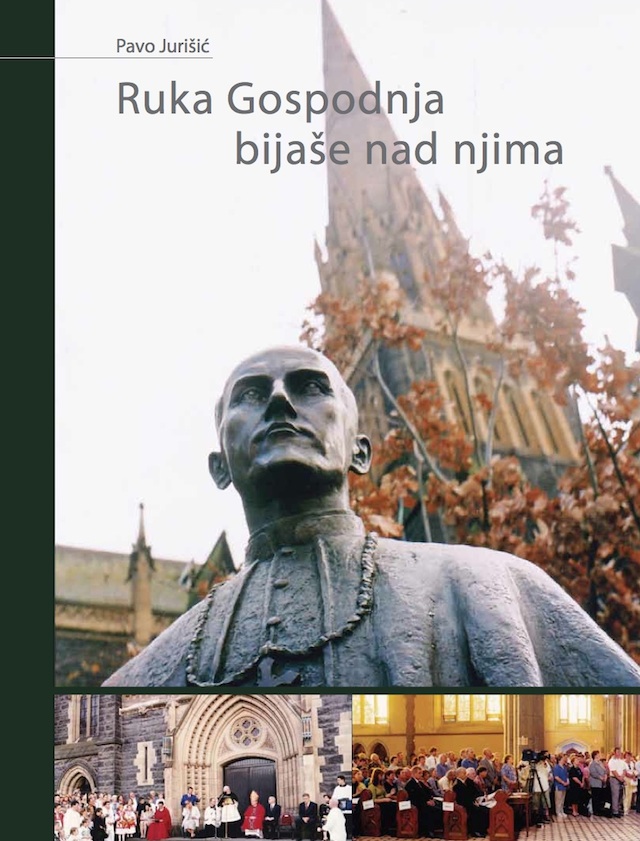 Dr Pavo Jurišić wrote an important monograph in 2015 about Croatians in Australia. There are two of its editions: Croatian and English. The English edition can be ordered in Australia at the following addresses: Croatian Catholic Center of St Nikola Tavelić, 69 Hodgkinson Street, Clifton Hill, Victoria 3068, Australia, or at the Croatian Catholic Center "St Spirit", 798-808 Springvale Rd., Keysborough, Victoria 3173, Australia. On the front page, the bust of Alojzije Stepinac in front of St Patrick's Cathedral in Melbourne. Croatian edition of the book can be purchased in Sarajevo: Knjižara "Izidor Poljak", Josipa Stadlera 5, 71000 SARAJEVO;
or Verbum bookshops in Croatia; or directly by contacting the author - pavo.jurisic@gmail.com
Introduction
To write the history of a country means to deal with its past, to seriously investigate the
present and analyse the processes that took place in its overall society in order to paint an accurate picture. It was not our original intention to write about the history of Australia, nor about the history of the Church in Australia, but to leave a written trace of the presence of the Croatian people in Melbourne and the organisation of the Croatian pastoral care in this part of the continent on the occasion of the 50th anniversary of the St. Nikola Tavelić Croatian Catholic Centre in Melbourne. Nonetheless, we will first discuss the history of Australia, the history of Christianity and the formation of the Catholic Church on the continent, based on published literature. We will then rely on archived material that has been preserved in the Croatian Catholic Centre in Clifton Hill in order to review the development of the Croatian Catholic community in the state of Victoria, particularly in Melbourne.
In the aftermath of the Second World War, the number of Croatian immigrants in Australia grew rapidly, so that the pre-war almost symbolic numbers of Croatian immigrants suddenly emerged as an important component both in the development of Australian society and for their own recognition in this country. They left their homeland in grave distress and in different ways found a refuge from the regime's persecution and torture in this distant world. In Australia, they sought a corner of freedom and the opportunity to work and make a living in order to provide their families with daily bread.
During the post WWII era, the largest number of Croats moved to Victoria where they had to struggle hard and endure hardships to find their own way in a foreign land. A small number sought help from Croatian immigrants who had arrived earlier. Of course, the political circumstances and adversities in their homeland had taken their toll on their relationship within the Croatian community in Melbourne while thwarting the efforts at their organizing and causing the disintegration of the Croatian national body.
The Croatian post-war community in Melbourne is in many ways deeply indebted to the Croatian Catholic priest Rev. Josip Kasić from the Archdiocese of Vrhbosna, who, like many others, escaped the persecution of the Yugoslav regime after the war, when he Yugoslavian secret services cruelly treated potential opponents of the regime, and Catholic priests in particular. Before fleeing the country, Kasić spent several years in a Yugoslav prison where he endured forced labour and was prohibited from carrying on any priestly duties. He was subjected to frequent harassment and threats on his life.
Brusque in his manner of speaking and working, yet determined to achieve his set goals, he escaped from the country and arrived in Australia in 1961. Upon his arrival, he immediately began his pastoral, cultural, charitable and, to some extent, political work, which lasted until he was forced to withdraw due to illness, spending his last years in peace preparing to meet with the Lord whom he tried his best to serve. He dedicated his entire life to the Croatian community in Melbourne; and, after his death, his earthly remains rest amongst those with whom he worked and to whom he dedicated his entire life. For this reason, we dedicate so much attention to his work in order for his commitment to remain in our everlasting memory.
Although his priestly work and approach to other people may have been subjected to stronger criticism, perhaps disclosing his unrelenting and domineering attitude in these relations, his distrust and strong resolve to keep everything under his control, he should, however, be commended for his love and commitment to the Croatian community, not only in Victoria, but throughout the Diaspora. However, given the fact that the Yugoslav secret service worked amongst our expatriates throughout the world, whereby many Croatian activists in the Diaspora were not only under surveillance, but also assassinated, Kasić’s distrust of others was to some extent understandable. Josip Kasić laid the foundations of the Croatian congregation in Melbourne. He was aided by other priests who kept coming over those fifty years. They served either as his assistants or working independently in the Lord's field, and thus, with the gifts of God, building on the work of the Croatian people in this country and helping them preserve and maintain ties with their native homeland.
Various records on the political, social and ecclesiastical circumstances among the Croats in this distant continent are stored in dishevelled archives of the Croatian Catholic Centre St. Nikola Tavelić in Clifton Hill, which testify to the fifty years of existence and work of the Centre. It was not my intention to engage in an in-depth discussion on all parts of its work, especially regarding the differences and divisions discussed and mentioned in various writings, notes and newspaper reports. Rather, I limit myself solely to the church and the pastoral work of our centres in Melbourne and the priests who made themselves available to everyone.
The book contains a statistical overview of the Croatian population in this region in order to leave a record for future generations to help them in tracing their roots, where they came from and where they can search for family ties in the old country. For this work I owe my thanks to two hard working associates, Ms. Mara Potočnjak from the Croatian Catholic Centre Clifton Hill and Ms. Kristina Butorac from the Croatian Catholic Centre Springvale, who worked on entering and recording the data from the Registers of Croatian Catholic ethnic communities in Melbourne. I also extend my thanks to all of those who supported this work both materially and spiritually, first of all to the Croatian priests in Melbourne, Rev. Mato Križanac, Rev. Ivica Zlatunić and Rev. Josip Vranješ, who were at hand in every respect when I was writing this book. I would also like to thank the many other people in Melbourne who helped so that this work could see the light of day, especially the brother and sister of the late Rev. Josip Kasić, who were very interested to learn of the preparation of this manuscript, tracing the life and work of their brother, who spent his life serving as a Croatian spiritual father in Victoria, thus laying the foundations of the organized Croatian congregation in this country. I thank the family of Marija and Milan Vučić who closely followed what I was doing, always lending a hand when needed, not only in the research materials used for this book, but also for all the meetings during my stay in Melbourne. I would also like to thank them for the moral and material help they provided to me and to other priests, bishops and church lay people who came here from the homeland. I thank them for the trips that I took with them in which I came to know Australia as a beautiful, rich country teeming with life and the melting pot of many different ethnic groups, those who claim Australia as their native land and others who have embraced this country as their second home.
I thank Mr. Branko Barbić for translating the manuscript into English, and Ms. Jennifer Wyman and Dragana Divković for proofreading the English text. Since some texts were written in a somewhat outdated form of Croatian orthography, mistakes were detected in some transcripts of documents in the archives of the Croatian Catholic Centre. We corrected the mistakes in the text whilst trying to preserve the authenticity of the original. Of course, like any work of human hands, this one is not short of flaws and deficiencies. But let those flaws serve as an impetus for new explorations where they would be corrected and amended.
Pavo Jurišić
| 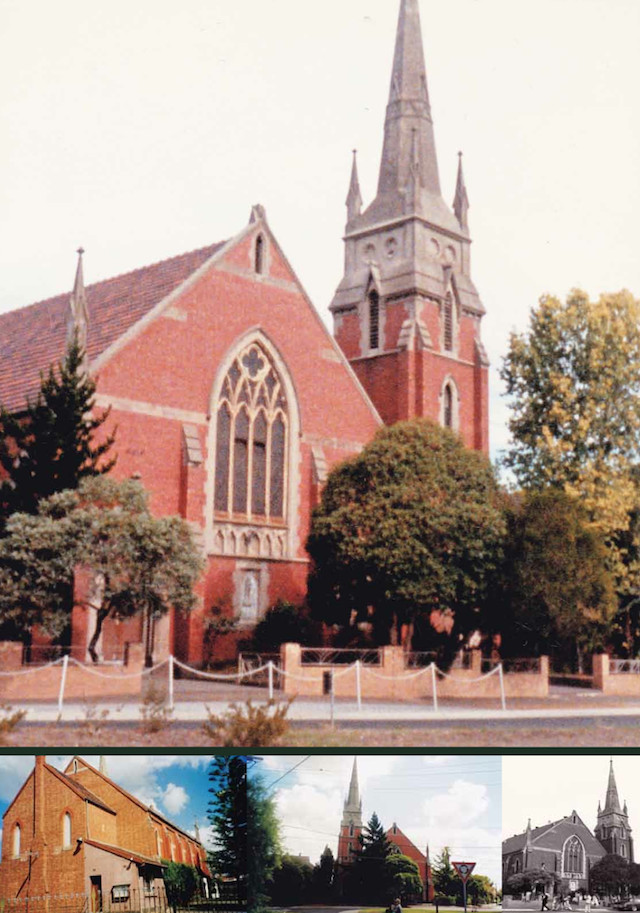 St Patrick's Cathedral in Melbourne is exhibited on the back cover of Dr Jurišić's monograph.
Conclusion
Throughout history, many individuals, families, or whole nations were often forced to leave their homeland and head off to distant lands to look for shelter from persecution or for economic security in order to save their own life and the lives of their families. One of the main causes of immigration is political persecution, forcing many to seek a place under the sun somewhere else for themselves and their families, a place where they can live a more normal life, a land where they would not be treated as the second-class citizens as they were in their own country, because they disagreed with the dictatorship or simply belonged to an ethnic, religious or ideological groups disfavoured by the keepers of history in their region.
Such was also Jesus’s earthly path. Although he was a helpless child, as soon as he was born, some people considered him "dangerous" and they did everything to get rid of him. That is why he had to flee to a foreign country to seek refuge from dangers and from a ruler who felt he was a threat. Yet, Egypt was not his destination but merely a transit station on his earthly journey in order to save himself for the task he must carry out. Golgotha is the station where he will complete the redemptive work on the cross, the work of God's infinite love for man, his creature.
Egypt was a country of refuge of Mary, Joseph and the baby Jesus, just as in salvation history this country was a refuge to Abraham and his sons. The escape of the holy family to Egypt, their return to their homeland after Herod was dead, and searching for a native land in which to settle clearly show us what difficulties they must have lived through and what hardships they had to overcome.
Their fate shares so many similarities with the fate of contemporary refugees and immigrants. The realities emerge before our eyes when we watch the daily news and remember our fellow countrymen who stayed in sufferance due to horrific killings and destruction. Even today, many refugees in all parts of the world flee for their lives relying on the kindness of foreigners and support from countries that accept them and give them solace. They begin new lives in foreign lands where everything is strange and new. They have a deep sense of gratitude for the security given to them and their families.
In the same way, Croats in all phases of their flight from their beloved homeland sought material and political security in different places in the free world. Many of them used sea routes and, later, aircraft which help them find the Australian continent, while forever leaving behind their homeland, their parents, their friends and weaknesses of the ethnic destruction of their home.
A large part of Australian Croats settled in the state of Victoria, and the majority in the area of the capital of this Australian state, Melbourne and surrounding areas. A smaller part of the Australian Croats arrived in Victoria before World War II, while a large part arrived in this country in the following decades.
As Catholic Croats in Victoria for a long time did not have their priests or regular pastoral care in the Croatian language, they found their way. They did their best to have their children baptized, to get married and bury their dead in the new and strange circumstances.
Since they didn't know the language and customs of the foreign land in which they settled, their life as refugees and immigrants in a foreign land was even harder. Therefore they were relieved and overjoyed when the first Croatian priests began to come and provide pastoral care.
It was a special blessing when Rev. Josip Kasić, the priest from the Archdiocese of Vrhbosna and a refugee himself arrived in Australia in May 1961. He shared the fate of the people but immediately put himself in charge and tried to create conditions in which he would be best in a position to help his people. He was hard-working and enterprising and quickly formed the Croatian community creating conditions for gathering, pastoral care and social assistance to all in need. In a year, he opened the first Croatian Catholic Centre in Melbourne with the church and buildings that would be used for the religious and cultural life of Croats in Victoria. Kasić developed many different pastoral and cultural activities. He began Croatian language and history schools and founded or participated in the creation of many cultural associations and organizations.
As a patriot, he fought hard for the Croatian people’s right to freedom, self-reliance, independence and equality. He tirelessly worked to establish the Croatian community as an honourable community within the multicultural and multiethnic Australian society. As a priest, he readily offered assistance to all, without distinction, who needed help.
This is witnessed by members of the Croatian community who had the opportunity to know him, listen to him, to work and live with him. He was full of enthusiasm and optimism, visiting Croats across Victoria, celebrating and sharing the sacraments with them, preaching to them and talking to them, announcing the gospel. He visited hospitals and prisons and many felt his moral support and material assistance.
But even though we all try to live as good Christians, we know there are few Saints on earth. Human beings should always be aware of their attachments to the earth and weaknesses they carry in and with them. We can learn a lot from these Croatian priests. However, no one is without fault. Kasić, as can be ascertained by reading through the archives, began to see himself as a father figure in the Croatian Catholic community in Victoria, the one whom all should listen to and go where he would send them.
This is particularly evident when other priests would arrive to the community to work with him in the vineyard of the Lord. There were occasional tensions which left him dissatisfied as we can see from notes that he occasionally wrote or in passing public comments. This can all be attributed to his temperament, born of the patriarchal environment in which he was raised. The older generations find it difficult to accept youthful desires for autonomy, and the young are not willing to accept authority that would most likely rein them in. This is exactly what sometimes happened in the relationship between Kasić and his younger colleagues.
But the strength of man is known when he finally rises above and accepts the reality as it is, pursuing the set goals and following reliably the path that he believes appropriate, knowing that with the acquired experience there is still something to say and plenty to do. This strength is reflected in Rev. Josip Kasić towards the end of his life, from the beginning of the nineties to his death. He welcomed the independence of Croatia, perhaps not in the way he imagined, but he was looking forward to fulfilling his patriotic endeavours. Although he was not able to visit his native country due to illness, he rejoiced in free Croatia with all his heart and soul.
Other centres emerged in Victoria and Melbourne after the original centre in Clifton Hill was built in 1962. First in Geelong and later two in Melbourne, one in Springvale under the protection of the Holy Spirit and the other in Sunshine under the protection of St. Leopold Mandić. These centres are now led by priests from the Archdiocese of Vrhbosna and are still active places where the Croatian community gathers to pray and work to preserve its Catholic and national identity including their customs and culture which they brought with them from the old country and which they chose to keep in this new land.
| 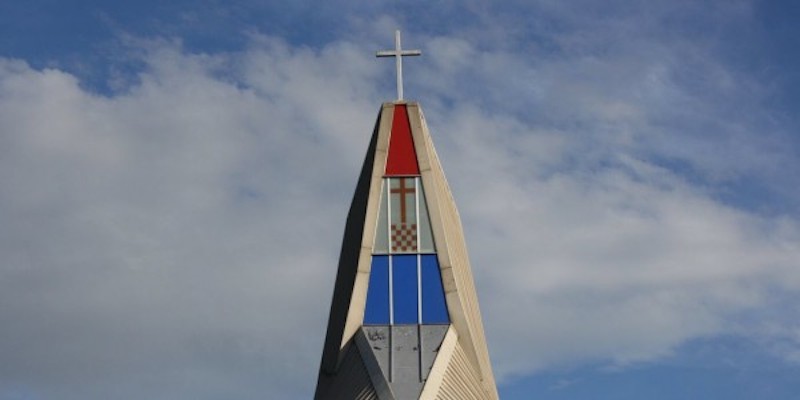 Croatian Catholic Centre Springvale, history
Publishers of Dr Pavo Jurišić's monograph:
Media Centre of the Archdiocese of Vrhbosna
Croatian Catholic Centre St. Nikola Tavelić, Clifton Hill
Translation from Croatian: Branko Barbić
Prepared and printed by Graforad in the town of Zenica, B&H
This monograph is dedicated to Croatian immigrants in Australia, especially those in Melbourne who lived their faith and represented their homeland, and to their fellow countrymen in Australia, their new homeland which accepted them and gave them shelter.
| Croatian Catholic Centre Sunshine (named after St Leopold Bogdan Mandic) Victoria, Australia. This centre is the major cultural attraction of Sunshine (suburb of Melbourne). A prominent Croatian artist Josip Botteri Dini participated in its completion:  Josip Botteri Dini Josip Botteri Dini from the city of Split, Croatia, on the right. 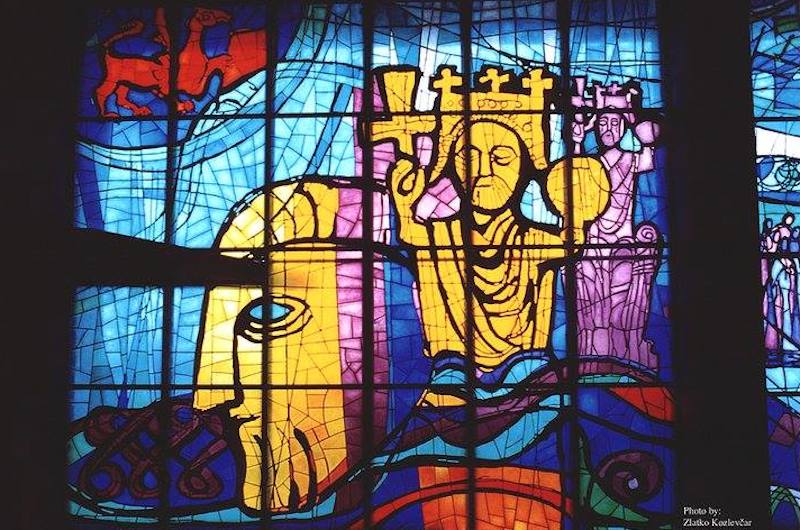 Glass mosaic in Sunshine created by Josip Botteri Dini, distinguished Croatian artist. Photo by Zlatko Kozlevčar.  Dr Franjo Tuđman, the first Croatian president, reading The Croatian Herald (Hrvatski vjesnik) during one of his visits to Australia. 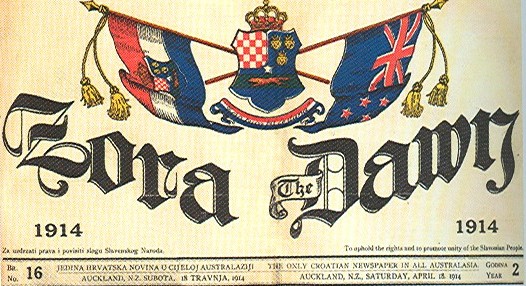
Zora - The Dawn, Croatian newspaper in Australia, Auckland, 1914
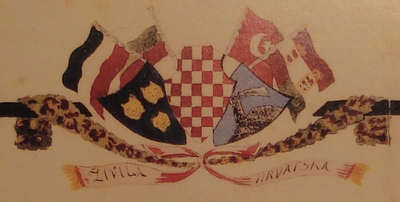
A painting of the Liverpool camp in Australia by a Croatian intenee during his internement there in 1916, ie in the course the First World War.
Coats of arms represent Dalmatia, Croatia and Bosnia, with the text below "Živila Hrvatska" (Long live Croatia). Potos from [Sutalo, pp 70-71]
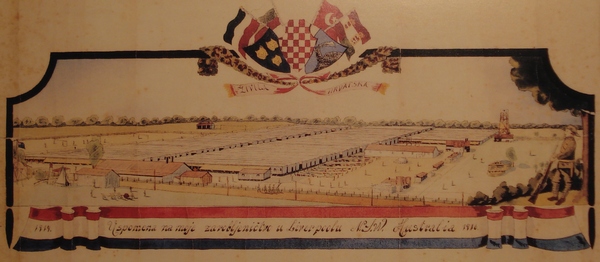
Australia, 1916, also with inscription Živila Hrvatska (Long Live Croatia) below the Croatian Coat of Arms.
Dr Pavo Jurišić in Slavonski Brod, the birthplace of Josip Stadler (1843-1918) distinguished Sarajevo archbishop. The process of Stadler's canonization started in 2002.
Dr. Pavo Jurišić, Sarajevo, BiH
Rođen 16. veljače 1958. u mjestu Ruda, općina Novi Travnik. Osnovnu je školu pohađao u rodnom kraju i u Odri kod Zagreba, gimnaziju kod franjevaca trećoredaca u Odri i Nadbiskupskoj klasičnoj gimnaziji u Zagrebu, gdje je maturirao 1975. Nakon završene gimnazije započinje studij filozofije i teologije u Zagrebu na Katoličkom bogoslovnom fakultetu, a završio je 1982. na Vrhbosanskoj katoličkoj teologiji u Sarajevu.
Nakon završenog studija teologije zaređen je za svećenika Vrhbosanske nadbiskupije 1982. Četiri godine djeluje kao kapelan na župama Sarajevo/Stup, Brčko i Crkvica u Zenici. Godine 1986. odlazi na postdiplomski studij u München, gdje na Teološkom fakultetu sveučilišta Ludwig Maximilian u Münchenu god. 1992. postiže doktorat iz katoličke teologije pri katedri Religijske pedagogije. U Münchenu je tijekom poslijediplomskog studija vršio službu kućnog svećenika u samostanu sestara Congregatio Jesu (Marije Ward) u Berg am Laim-u, gdje kao vjeroučitelj i duhovnik ispomaže na djevojačkoj realnoj gimnaziji koju su vodile sestre. Nakon završenog poslijediplomskog studija vraća se u domovinu te od listopada 1992. djeluje kao profesor pedagogije, didaktike, metodike vjeronaučne nastave, misiologije i njemačkog jezika na Vrhbosanskoj katoličkoj teologiji. Na toj visokoškolskoj ustanovi vršio je službu tajnika škole do 2007., a od 1998. do 2007. službu prodekana. Kada je 2009. Vrhbosanska katolička teologija uzdignuta na rang bogoslovnog fakulteta imenovan je od Kongregacije za katolički odgoj u Rimu prvim dekanom toga fakulteta.
Druge službe u Crkvi i Nadbiskupiji: godine 1996. dekretom nadbiskupa imenovan je da skuplja arhivsku građu o blagopokojnom nadbiskupu dr. Josipu Stadleru; s tim je dekretom osnovao 1997. Centar za prikupljanje građe o nadbiskupu Stadleru, koji će nakon imenovanja postulatorom kauze Sluge Božjega Josipa Stadlera u dijecezanskom postupku 2000. godine prerasti u ured Postulature. Nakon završetka postupka na dijecezanskoj razini 2008. Kongregacija za kauze svetaca u Rimu imenuje ga postulatorom te kauze i na rimskoj razini.
Od 1996. voditelj Teološkog instituta u Sarajevu; bio je član Vijeća za katehizaciju Hrvatske biskupske konferencije od 1996. do 2003., a od 1997. do 2009. član Katehetskog vijeća Biskupske konferencije Bosne i Hercegovine; od 2002. član je i Pedagoškog vijeća Katoličkih škola za Europu (obavlja službu tajnika Vijeća). Kao profesor pedagogije i katehetike predavao je na Katehetskom institutu u Dubrovniku, a još uvijek predaje na Teološkom institutu u Mostaru.
Dr. Pavo JURIŠIĆ
Profesor religijske pedagogije i misiologije
Josipa Stadlera 5
71000 Sarajevo
Izvor Katolički bogoslovni fakultet, Sarajevo, B&H
|  Dr Pavo Jurišić with one of the boys from Uzdol after the Communion ceremony. Note that Dr Jurišić's breast is decoreated with the figure of Alozije Stepinac and with the Latin inscription IN TE DOMINE SPERAVI. Formated for CROWN by Darko Žubrinić
Distributed by www.Croatia.org . This message is intended for Croatian Associations/Institutions and their Friends in Croatia and in the World. The opinions/articles expressed on this list do not reflect personal opinions of the moderator. If the reader of this message is not the intended recipient, please delete or destroy all copies of this communication and please, let us know!
|